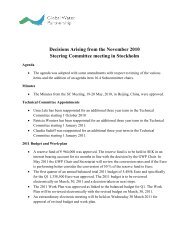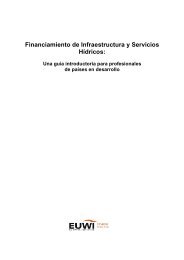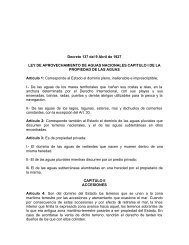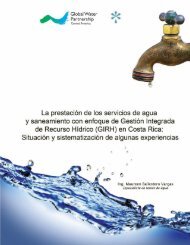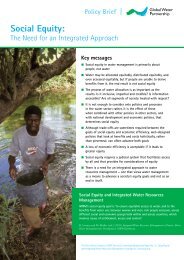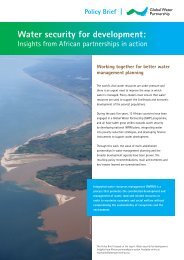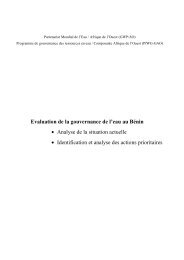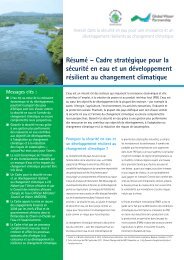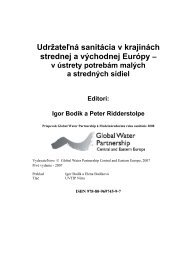Monitoring and evaluation indicators for IWRM strategies and plans
Monitoring and evaluation indicators for IWRM strategies and plans
Monitoring and evaluation indicators for IWRM strategies and plans
You also want an ePaper? Increase the reach of your titles
YUMPU automatically turns print PDFs into web optimized ePapers that Google loves.
Step 2: Define <strong>indicators</strong> <strong>for</strong> each target based on stakeholder consultations <strong>and</strong> on criteria,<br />
such as relevance, reliability, <strong>and</strong> cost-effectiveness. Involve stakeholders who cause or<br />
are affected by the problem or issue addressed in the target; who have relevant in<strong>for</strong>mation<br />
or expertise; <strong>and</strong> who will be responsible <strong>for</strong> implementing <strong>indicators</strong>.<br />
“<br />
Stakeholders to<br />
involve include<br />
those who cause or<br />
are affected by the<br />
problem or issue to<br />
be addressed; those<br />
with relevant in<strong>for</strong>mation<br />
or expertise;<br />
<strong>and</strong> those who will<br />
be responsible <strong>for</strong><br />
implementing<br />
<strong>indicators</strong>.<br />
Step 3: Select <strong>indicators</strong> to track human <strong>and</strong> financial resources <strong>and</strong> ensure that they are being<br />
disbursed <strong>and</strong> used efficiently.<br />
Step 4: Check to make sure that <strong>indicators</strong> relate clearly to targets, <strong>and</strong> that these in turn support<br />
the achievement of actions, objectives <strong>and</strong> goals. Identify <strong>and</strong> fill gaps. Refine <strong>indicators</strong><br />
<strong>and</strong>/or targets as necessary. This step may involve taking an inventory of <strong>indicators</strong><br />
that are already in use in the country to eliminate redundancies, <strong>and</strong> also considering<br />
the relationship of national M&E ef<strong>for</strong>ts to international monitoring programs—such<br />
as the World Water Assessment Programme.<br />
Step 5: Calculate human <strong>and</strong> financial resources needed to apply the indicator package.<br />
Evaluate whether the package is a good investment, i.e. the human <strong>and</strong> financial<br />
resources required are commensurate with the value of the various <strong>indicators</strong><br />
employed.<br />
Step 6: Agree on the agencies/institutions that will be responsible <strong>for</strong> applying the different <strong>indicators</strong>,<br />
how, <strong>and</strong> how often.<br />
Step 7: Determine how the in<strong>for</strong>mation resulting from the different <strong>indicators</strong> will be managed:<br />
how it fits into decision-making processes, both specifically related to the strategy but<br />
also ongoing policy <strong>and</strong> planning processes; how in<strong>for</strong>mation will be amalgamated to<br />
get a more comprehensive picture of progress; <strong>and</strong> how it will be communicated to<br />
stakeholders.<br />
Step 8: Include requirements <strong>for</strong> M&E package in capacity building plan, budget, <strong>and</strong> staff allocation.<br />
Some nuts <strong>and</strong> bolts of establishing an M&E system<br />
Determining frequency of monitoring <strong>and</strong> reporting: Should be based on how<br />
rapidly conditions are changing <strong>and</strong> the significance of change. In general, processes need<br />
to be monitored frequently <strong>and</strong> need to be part of regular management activities. Action<br />
monitoring is generally tied to specific milestones. Objectives have a longer time horizon—depending<br />
on the specific objective, this may mean monthly, quarterly, biannual,<br />
or annual monitoring. Progress on goals may take many years to emerge, this may mean<br />
annual monitoring, but reporting every three years or even every five years—again<br />
depending on the targets defined.<br />
Coordinating monitoring ef<strong>for</strong>ts across agencies (see also Catalyzing Change, pp.<br />
29-31, on building a knowledge base): Creating the kind of M&E system needed <strong>for</strong> an<br />
<strong>IWRM</strong> strategy often involves linking the data collection activities of multiple agencies.<br />
This can be a challenge, especially if agencies are not used to working together, much less<br />
sharing in<strong>for</strong>mation. One possible solution is to create a monitoring <strong>and</strong> <strong>evaluation</strong> unit<br />
or task <strong>for</strong>ce, with representation from organizations <strong>and</strong> agencies carrying out relevant<br />
monitoring activities. Also make sure that agencies underst<strong>and</strong> how the data they provide<br />
is being used <strong>and</strong> that the flow of in<strong>for</strong>mation is not solely one way.<br />
6



